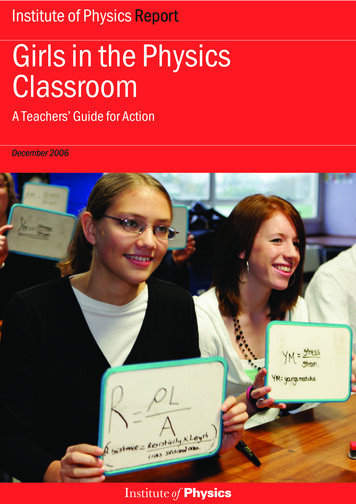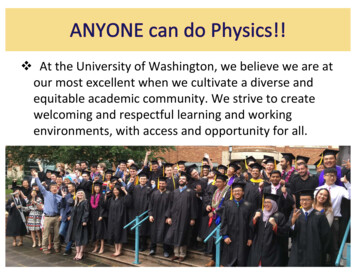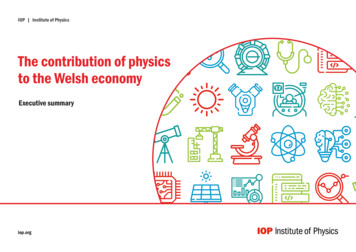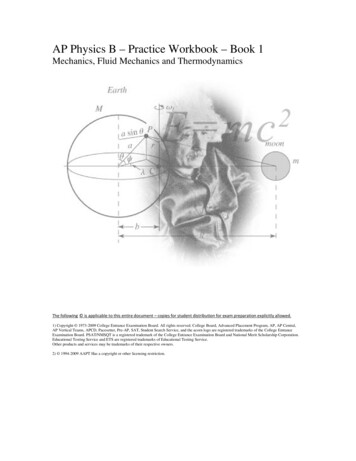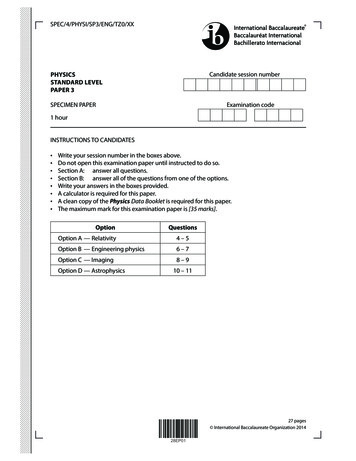
Transcription
SPEC/4/PHYSI/SP3/ENG/TZ0/XXCandidate session numberPHYSICSSTANDARD LEVELPAPER 3Examination codeSPECIMEN PAPER1 hourINSTRUCTIONS TO CANDIDATESWrite your session number in the boxes above.Do not open this examination paper until instructed to do so.Section A: answer all questions.Section B: answer all of the questions from one of the options.Write your answers in the boxes provided.A calculator is required for this paper.A clean copy of the Physics Data Booklet is required for this paper.The maximum mark for this examination paper is [35 marks].OptionQuestionsOption A — Relativity4–5Option B — Engineering physics6–7Option C — Imaging8–9Option D — Astrophysics10 – 1127 pages International Baccalaureate Organization 201428EP01
SPEC/4/PHYSI/SP3/ENG/TZ0/XX–2–SECTION AAnswer all questions. Write your answers in the boxes provided.1.The speed of sound in air, v, was measured at temperatures near 0 C. The graph shows the datav / m s–1 350340330320–20–1031000/ C1020A student suggests that the speed of sound v is related to the temperatureby the equationvin degrees Celsiusa bwhere a and b are constants.(a)(i)Determine the value of the constant a[1].(This question continues on the following page)28EP02
–3–SPEC/4/PHYSI/SP3/ENG/TZ0/XXEstimate the absolute uncertainty in b.[3](Question 1 continued)(ii).(iii) A student calculates that bvalue of b0.593m s1C 1. State, using your answer to (a)(ii), the[1].(b)(i)Estimate the temperature at which the speed of sound is zero.[1].(ii)Explain, with reference to your answer in (b)(i), why the student’s suggestionis not valid.[2].Turn over28EP03
–4–2.SPEC/4/PHYSI/SP3/ENG/TZ0/XXA student uses an electronic timer in an attempt to estimate the acceleration of free-fall g.She measures the time t taken for a small metal ball to fall through a height h of 0.50 m.The percentage uncertainty in the measurement of time is 0.3 % and the percentage uncertaintyheight is 0.6 %.(a)Using h1 2gt , calculate the expected percentage uncertainty in the value of g.2[1].(b)State and explain how the student could obtain a more reliable value for g.28EP04[3]
–5–SPEC/4/PHYSI/SP3/ENG/TZ0/XX3.100 C. The metal is then transferred into a calorimeterinside a container of boiling water at 100containing water at a temperature of10010 Cmeasured. One source of error in this experiment is that a small mass of boiling water will betransferred to the calorimeter along with the metal.(the metal.[2].(b)State one other source of error for this experiment.[1].Turn over28EP05
–6–SPEC/4/PHYSI/SP3/ENG/TZ0/XXSECTION BAnswer all of the questions from one of the options. Write your answers in the boxes provided.Option A — Relativity4.(a)Einstein discovered a discrepancy, related to the speed of light, between Maxwell’sequations of electromagnetism and Newtonian mechanics. Outline the discrepancy andhow Einstein dealt with it.[2].(Option A continues on the following page)28EP06
–7–SPEC/4/PHYSI/SP3/ENG/TZ0/XX(Option A, question 4 continued)(the page as shown.protonmeasured to be v in S.(i)State the nature of the force on the proton according to an observer in S.[1].(ii)S is a reference frame in which the proton is at rest. State and explain whether,according to an observer in S , there is a force on the proton.[2].(Option A continues on the following page)Turn over28EP07
SPEC/4/PHYSI/SP3/ENG/TZ0/XX–8–(Option A continued)5.A rocket of proper length 900 m is moving at speed 0.80c relative to the Earth. E is a referenceframe in which the Earth is at rest. R is a reference frame in which the rocket is at rest.The diagram is from the point of view of eption(a)EarthA light signal is emitted from the back of the rocket and is received at the front ofthe rocket.Determine the(i)time interval between the emission and reception of the light signal according toan observer in R.[1].(ii)time interval between the emission and reception of the light signal according toan observer in E.[3].(Option A continues on the following page)28EP08
–9–SPEC/4/PHYSI/SP3/ENG/TZ0/XX(Option A, question 5 continued)(iii) distance separating the emission and reception of the light signal according toan observer in E.[1].(Option A continues on the following page)Turn over28EP09
SPEC/4/PHYSI/SP3/ENG/TZ0/XX– 10 –(Option A, question 5 continued)(b)One photon is emitted from the back B of the rocket and another photon is emitted fromthe front F of the rocket, as shown.RphotonphotonBFThe emissions are simultaneous according to observers in R. The photons are received byan observer at rest in the middle of the rocket.The spacetime diagram represents the reference frame of the Earth E and the rocketframe R. The coordinates in frame E are x and ct and in frame R they are x and ct .The position of the back B and of the front F of the rocket at t 0 are labelled.The origin of the axes corresponds to the middle of the rocket.ctctrocketframe xF00xEarth frameB(i)On the spacetime diagram, draw lines to show the worldlines of the photons fromwhen they were emitted to when they were received.[3](Option A continues on the following page)28EP10
– 11 –SPEC/4/PHYSI/SP3/ENG/TZ0/XX(Option A, question 5 continued)(to observers in E.[2].(iii) Determine the time separating the emissions of the two photons according toobservers in E.[2].(c)A missile is launched from the rocket. The velocity of the missile is – 0.62c relative tothe rocket. Calculate the velocity of the rocket relative to the Earth.[3].End of Option ATurn over28EP11
– 12 –SPEC/4/PHYSI/SP3/ENG/TZ0/XXOption B — Engineering physics6.A bucket of mass m is held above a water well by a rope of negligible mass, as shown.The rope is wound around a cylinder of mass M and radius R. The moment of inertia ofthe cylinder about its axis is I 12 MR 2.horizontalaxisRcylinder mass Mropebucket mass m(not to scale)The bucket is released from rest. Resistance forces may be ignored.(a)Show that the acceleration a of the bucket is given by the following equation.amg.Mm2[4].(Option B continues on the following page)28EP12
SPEC/4/PHYSI/SP3/ENG/TZ0/XX– 13 –(Option B, question 6 continued)(b)The following data are available.Bucket mass mCylinder mass MRadius R(i)24 kg36 kg0.20 mCalculate the speed of the bucket when it has fallen a distance of 16 m from rest.[2].(ii)Calculate the rate of change of the angular momentum of the cylinder.[3].(raised at a constant speed of 2.0 m s–1 using an electric motor attached to the cylinder.Calculate the power output of the motor.[1].(Option B continues on the following page)Turn over28EP13
SPEC/4/PHYSI/SP3/ENG/TZ0/XX– 14 –(Option B continued)7.The pressure volume (pV) diagram shows a cycle ABCA of a heat engine. The working65AB4p / 105 Pa32C10024V / 10–3 m36810The temperature of the gas at A is 400 K.(a)Calculate the maximum temperature of the gas during the cycle.[1].(Option B continues on the following page)28EP14
– 15 –SPEC/4/PHYSI/SP3/ENG/TZ0/XX(Option B, question 7 continued)(b)For the isobaric expansion AB, calculate the(i)work done by the gas.[2].(ii)change in the internal energy of the gas.[1].(iii) thermal energy transferred to the gas.[1].(Option B continues on the following page)Turn over28EP15
– 16 –SPEC/4/PHYSI/SP3/ENG/TZ0/XX(Option B, question 7 continued)(c)The work done on the gas during the isothermal compression is 1390 J. Determine thechange in entropy of the gas for this compression.[2].([2].(as those operating in cycle ABCA on page 14, would be greater than, equal to, or less than[1].End of Option B28EP16
– 17 –SPEC/4/PHYSI/SP3/ENG/TZ0/XXPlease do not write on this page.Answers written on this pagewill not be marked.Turn over28EP17
– 18 –SPEC/4/PHYSI/SP3/ENG/TZ0/XXOption C — Imaging8.mirror M , a large converging mirror M , and a converging lens L. The focal point ofM2 is at F.M2light from adistant planetFM1L(not to scale)The telescope is used to view a planet. The diameter of the planet subtends an angle of1.40 10–4 rad at M . The focal length of M2 is 9.50 m.(i)Show that the diameter of the image of the planet that would be formed by M2 aloneis 1.33 mm.[3].(Option C continues on the following page)28EP18
– 19 –SPEC/4/PHYSI/SP3/ENG/TZ0/XX(Option C, question 8 continued)(ii)M1 is at a distance of 8.57 m from the aperture of M . The image in (a)(i) nowserves as a virtual object for M1. A real image is formed at the opening of M .Show that the diameter of this image is 12.0 mm.[3].(the telescope.[3].(Option C continues on the following page)Turn over28EP19
– 20 –SPEC/4/PHYSI/SP3/ENG/TZ0/XXspherical. Suggest one reason for this.[1](Option C, question 8 continued)(.(ii)State one[1].(c)Telescopes available today include, in addition to optical telescopes, infrared, radio,ultraviolet and X-ray telescopes. Outline how the introduction of these telescopes haschanged our view of the universe.[2].(Option C continues on the following page)28EP20
– 21 –SPEC/4/PHYSI/SP3/ENG/TZ0/XX(Option C continued)9.(a)A compound microscope has an objective lens of focal length 0.40 cm and an eyepiecelens of focal length 3.20 cm. The image formed by the objective is 0.20 m from the(i)Show that the position of the object is 4.1 10–3 m from the objective lens.[1].([2].(iii) The smallest distance between two points that can be distinguished by anunaided human eye from a distance of 25 cm is approximately 0.1 mm.Calculate the smallest distance between two points that can be distinguished usingthis microscope.[1].(Option C continues on the following page)Turn over28EP21
– 22 –SPEC/4/PHYSI/SP3/ENG/TZ0/XX(Option C, question 9 continued)(The input power of the signal is 120 mW and the attenuation per unit length of the–1of the signal.[3].End of Option C28EP22
SPEC/4/PHYSI/SP3/ENG/TZ0/XX– 23 –Option D — Astrophysics10.(a)State the element which is the end product of nuclear reactions taking place insidemain sequence stars.[1].(b)A main sequence star has apparent brightness 7.6 10–14 W m–2 and luminosity 3.8 1027 W.(i)Calculate, in pc, the distance of the star from Earth.[3].(ii)Suggest whether the stellar parallax method is appropriate for measuring thedistance to this star.[1].(iii) The luminosity of the star in (b) is ten times the luminosity of our Sun.Determine the ratioMwhere M is the mass of the Sun.M[2].(Option D continues on the following page)Turn over28EP23
– 24 –SPEC/4/PHYSI/SP3/ENG/TZ0/XX(Option D, question 10 continued)(c)The image shows a Hertzsprung–Russell (HR) diagram.100 00010 000100010010luminosity(Sun 1)1main sequence0.10.010.0010.0001white dwarfs0.0000130000K 10000K 7500K6000K5000K4000K3000Ktemperature(Option D continues on the following page)28EP24
– 25 –SPEC/4/PHYSI/SP3/ENG/TZ0/XX(Option D, question 10 continued)(i)Estimate, using the HR diagram, the ratioin (b) and R is the radius of the Sun.Rwhere R is the radius of the starR[3].(ii)Sketch a line on the HR diagram to show the evolutionary path of this star.[2](iii) Describe, with reference to the Chandrasekhar limit, the equilibrium state of this[2].(Option D continues on the following page)Turn over28EP25
SPEC/4/PHYSI/SP3/ENG/TZ0/XX– 26 –(Option D continued)11.(a)The hydrogen spectrum from a laboratory source includes a line of wavelength 434 nm.The same line emitted from a distant galaxy has wavelength 502 nm when observedon Earth.(i)Suggest why the two wavelengths are different.[1].(ii)Determine the distance, in Mpc, from this galaxy to Earth using a Hubble constantof 71 km s–1 Mpc–1.[2].(Option D continues on the following page)28EP26
– 27 –SPEC/4/PHYSI/SP3/ENG/TZ0/XX(Option D, question 11 continued)(b)In the 1990s, two research groups started projects involving observations of distantsupernovae. They aimed to show that distant galaxies were slowing down.(i)Suggest why it was expected that distant galaxies would be slowing down.[1].(ii)Describe how it was deduced that the universe is expanding at an accelerated rate.[2].End of Option DTurn over28EP27
Please do not write on this page.Answers written on this pagewill not be marked.28EP28
15 pagesSPEC/4/PHYSI/SP3/ENG/TZ0/XX/MPaper 3Standard LevelPHYSICSSPECIMEN PAPERMARKSCHEME
A question subpart may have more marking points than the total allows. This will be indicated by “max” written after the mark in the “Total” column. The relatedrubric, if necessary, will be outlined in the “Notes” column.An alternative wording is indicated in the “Answers” column by a slash (/). Either wording can be accepted.An alternative answer is indicated in the “Answers” column by “OR” on the line between the alternatives. Either answer can be accepted.4.5.6.Words in angled bracketsWords that are underlined are essential for the mark.The order of marking points does not have to be as in the “Answers” column, unless stated otherwise in the “Notes” column.If the candidate’s answer has the same “meaning” or can be clearly interpreted as being of equivalent significance, detail and validity as that in the “Answers”column then award the mark. Where this point is considered to be particularly relevant in a question it is emphasized by OWTTE (or words to that effect) inthe “Notes” column.Remember that many candidates are writing in a second language. Effective communication is more important than grammatical accuracy.7.8.9.10.11.‹ › in the “Answers” column are not necessary to gain the mark.Each marking point in the “Answers” column is shown by means of a tick ( ) at the end of the marking point.23.NotesAccept force for acceleration.The maximum mark for each question subpart is indicated in the “Total” column.Answers2.are in opposite directionsthe displacement and accelerationEach row in the “Question” column relates to the smallest subpart of the question.Questionbii1.4.Markscheme format es are required to answer ALL questions in Section A [15 marks] and all questions from ONE option in Section B [20 marks].Maximum total [35 marks].Mark AllocationSubject Details: Physics SL Paper 3 MarkschemeGeneral Marking Instructions–2–
Occasionally, a part of a question may require an answer that is required for subsequent marking points. If an error is made in the first marking point then it shouldbe penalized. However, if the incorrect answer is used correctly in subsequent marking points then follow through marks should be awarded. When marking,indicate this by adding ECF (error carried forward) on the script. “ECF acceptable” will be displayed in the “Notes” column.Do not penalize candidates for errors in units or significant figures, unless it is specifically referred to in the “Notes” column.13.SPEC/4/PHYSI/SP3/ENG/TZ0/XX/M12.–3–
1.iiiiiiiiiaaabbQuestion1›‹ 340‹ 0.70bminb0.55C1CC11›››› 0.08 ‹ m s111C1›it appears that the linear fit model cannot be extrapolated far from 0 C330› 550 ‹ C ›0.6temperature is unphysicalORthere is no temperature below 273 CORthis temperature cannot be right‹10.075› 0.55 ‹ m s› 0.70 ‹ m sb 0.59 ( 0.08) ‹ m s231840‹ 34431640330 ‹ m sbmaxaAnswersSECTION A–4–Allow 0.5930.075) .Notes21131TotalSPEC/4/PHYSI/SP3/ENG/TZ0/XX/M
3.babQuestion2.awater may not be at uniform temperatureenergy may have been lost to the air through the calorimeterenergy was lost to air during the transfermetal may not have been heated uniformlyORmetal may not all be at 100 Cmore thermal energy is transferred to the calorimeter and contents than accounted forthe actual specific heat capacity will be less than calculated valuerepeat many times ‹to get an average of time›use a ‹much› larger heightuse a smaller ball ‹to reduce air resistance›ORg is twice the gradientobtain g from a suitable graph ‹of height h versus t 2 ›use more than one heightAnswersthe estimated percentage uncertainty in g ‹ is 2 0.3 0.6 › 1%–5–Do not allow a bald answer.Allow h versus t 2 or h versus tor logh logt .Analysis of g must fit quotedgraph.Accept 1.2 %.Notes1 max231TotalSPEC/4/PHYSI/SP3/ENG/TZ0/XX/M
5.iiiaiiiabbQuestion4.a‹26‹s ›3›561.67› 5 3.0 10311 0.646v xc210‹s›tv1 2c19.0 10t‹c‹ 900 › 3.00.80c 900c2cannot be magnetic because the proton is at rest in Sif a force exists in one ‹inertial› frame a force must exist in any other ‹inertial› frameEinstein trusted Maxwell’s equationsOREinstein modified Newtonian mechanicsmagneticAnswersMaxwell’s equations implied a speed of light independent of its sourceORin Newtonian mechanics, speed of light depends on velocity of sourceOption A — RelativitySECTION B–6–Accept discussion in terms ofacceleration as equivalent toforce.Accept an answer in terms ofelectric field.Notes(continued )31212TotalSPEC/4/PHYSI/SP3/ENG/TZ0/XX/M
biQuestionaiii‹‹ ctxBv t6› 2700 ‹ m ›0correct slope at 45 degreesending at the same point on the ct axis0ctFctxrocketframe x› 2700 ‹ m ›Answers5900900 0.80c3c3.0 108 9.0 10starting points at B and FxORx(Question 5 continued)–7–Earth frameJudge by eye.Notes(continued )31TotalSPEC/4/PHYSI/SP3/ENG/TZ0/XX/M
cbiiiQuestionbiiB0ct04.0 10t6‹s›v xc23›5correct answer of 0.36ccorrect substitutionsolving for u‹ttto see that B happened first0FAnswersct0.80c [900]c2lines through B and F parallel to x-axis(Question 5 continued)xrocketframe x–8–Earth frameNotes322TotalSPEC/4/PHYSI/SP3/ENG/TZ0/XX/M
biQuestion6.a12maMR 2aRv‹mghORmghOR21 v2I2 R21 2I21›13 ‹ m s13 ‹ m s› 13.4› 13.42 5.6 162› 5.6 ‹ m s ›2 24 9.8 1624 181 2mv21 2mv22as‹v9.836242‹ 24a1›maAnswers‹add equations/eliminate tension› to get mgmg TT RaROption B — Engineering physics12Ma–9–Award [2] for a bald correctanswer.Notes(continued )24TotalSPEC/4/PHYSI/SP3/ENG/TZ0/XX/M
cQuestionbiiMR 2aR2›11236‹P24 9.836242aR45 9.8 2.0› 882880 ‹ W ›24 9.80.203624220.2 20 ‹ N m ›TRrate of change of L isIAnswers‹torque on axle›36 0.2020.2 20 ‹ N m ›12OR‹rate of change of L is I(Question 6 continued)– 10 –NotesAward [3] for a bald correctanswer.13TotalSPEC/4/PHYSI/SP3/ENG/TZ0/XX/M
iiiiibbedcibQuestion7.a8233.0 1032› 4.53.5 ‹ J K1›3› 1600 ‹ K ›› 7.5103 ‹ J ›103 ‹ J ›105 [8.0 2.0] 104003.0 103 4.5 10313904003000 139075003.48Se 0.21greatereV› 5.0‹J›U WQT‹2‹3 pSQU3.0 103WV‹pWB‹ maximum is at B and so TAnswers– 11 –Award [1] for a bald correctanswer.Award [1 max] for omitted minussign.Award [2] for a bald correctanswer.Award [2] for a bald correctanswer.Award [1] for a bald correctanswer.Award [2] for a bald G/TZ0/XX/M
00with parabolic mirrors the problem of spherical aberration is eliminated40.126 ‹ rad ›0.1261.40 1012.3 ‹ mm ›98.0 ‹ mm ›magnification:angle:the diameter of this image is then 9.215 0.00133 0.012256 ‹ m ›so the magnification is40.93 ‹ m ›9.50 1.40 10the object distance is [9.50 8.57]0.00133 ‹ m ›Diu‹ › 9.50very large›at a distance of 9.5
frame R. The coordinates in frame E are x and ct and in frame R they are xc and ctc. The position of the back B and of the front F of the rocket at tc 0 are labelled. The origin of the axes corresponds to the middle of the rocket. ctc B ct 0 0 F rocket frame x xc Earth frame


